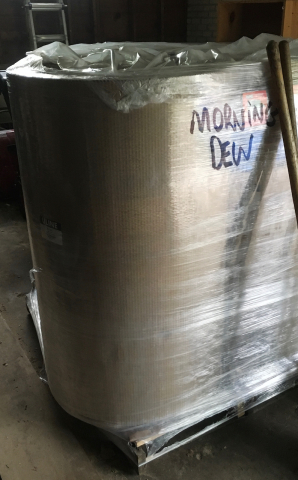Pretty much every year the city has occasion to send me a letter telling me to do something or another with my prairie. The last couple of years, this has occurred due to some of the plants getting taller than expected/planned and leaning over the sidewalk. This gets to be especially annoying for passers-by if the leaning plants are the
cup plants, which collect little cups of water where their leaves grasp the stem. This provides a nice source of water for birds, insects, and small mammals, but also provides a bit of a shower to anyone brushing against them. Not desirable in the best of circumstances and possibly a hazard for some. In addition, partially blocking the sidewalk causes undue difficulty for anyone with a disability. So steps needed to be taken.
So I purchased some garden stakes. First a set of bamboo ones, but when those proved a bit too weak I got some coated steel stakes of various sizes from the garden center. Placing these along the sidewalk, I run some twine between them and create a make-shift fence that keeps things from falling over where they aren't wanted. After the strong storms and rain yesterday, a few other things were starting to get in the way of the walk to the front door, which would inconvenience mail carriers and those making deliveries. Since delivery is more important in these days of sheltering in place, I added more of this barrier design to hold those things out of the way as well.
(One of the things that makes this necessary is that all my plants grow crazily taller than they should.
Ohio spiderwort typically grows about two feet tall. Mine is about three.
Brown-eyed Susan you typically see one to three feet tall. Mine grows five to six feet tall. These aren't outside the known ranges for the plants, but it is unusual. And it mucks with my planning. When you plan for something to be about three feet tall and it grows to six, the place you planted it may not be wholly appropriate.)
Today also started the process of doing a reset on the backyard landscape. Since we had two large dogs for 12 years, doing any formal landscaping in the back yard was doomed to failure. The best I did was keep the undesirable plants down to a dull roar. So now I'm looking to expand the native plantings on the property into the backyard, but doing so in a way that leads to a more organized aesthetic feel. This starts with sheet composting the entire back yard.
The process of sheet composting involves mowing down anything that currently exists, covering the area with of few inches of compost, soaking that with molasses water, covering it with layers of cardboard, and topping it all off with additional inches of mulch. The idea is that the sugar feeds the microbes in the compost, helping them break down anything else at the bottom of the stack, including anything that tries growing back. The cardboard blocks out any sunlight so new things don't germinate and old things have a harder time growing back. And the top mulch keeps it all moist so the composting does its work and allows anything germinating on top to be removed fairly easily. This all sits and cooks for the rest of the year and then we plant new things in the spring.
We're planning to talk to a landscape architect that specializes in native plants to work out what to plant. We've got the first meeting scheduled for early July, but her actual design schedule is booked until November. Given the overall timing of the plan, that seems like it will work out well.
The first step of the sheet composting (mowing everything down and removing things like fallen tree limbs) was completed today. The layering on of compost, cardboard, and mulch is planned for Friday.











